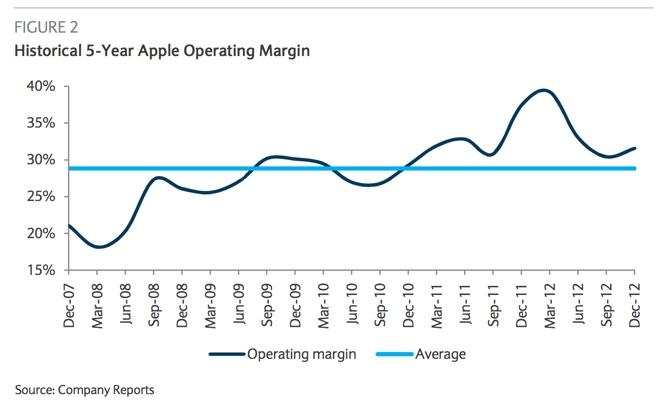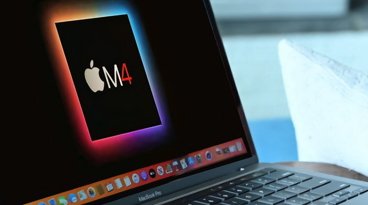Apple's 128GB iPad aims to drive profits up a path competitors can't easily follow
Apple's surprise unveiling of a new "fat" iPad 4 model equipped with 128 gigabytes of storage expands the company's tablet platform offerings into premium territory, a feat its competitors will have trouble duplicating.
The introduction of a new high-capacity iPad is significant in several respects. First, Apple appears to have successfully "doubled down" in securing secrecy as its chief executive Tim Cook promised to do last summer. The first inkling of the new fat iPad was first floated over the weekend, just one business day before it was officially announced.
Perhaps more importantly, the surprise announcement also demonstrates how quickly (and unpredictably) Apple can shift direction. Since the introduction of the iPad mini last fall, critics have complained that the smaller form factor iPad didn't deliver an sharp enough screen to attract customers and, at the same time, that widespread adoption of the lower priced model would erode the company's relatively high margins.
It turned out they were at least half right in that contradictory prediction: Apple outlined that its margins could decrease in the coming quarter due to selling a large number of the very popular new lower priced iPad minis.
However, the iPad's critics are so preoccupied with the notion that low prices alone can drive sales that they failed to anticipate that Apple could also offer a new, more expensive and higher capacity full sized iPad, or that there could be an audience for it.
If it is successful in selling in meaningful quantities, the larger capacity, higher margin new fat iPad has the potential to disrupt the predicted direction of Apple's margins. The same disruption of pundits' expectations has occured time after time over the last decade as Apple has released alluring new products that have broken the ostensible trend toward cheaper commodity devices.
How big of a development is a 128-gigabyte iPad?
At first glance, Apple's 128-gigabyte iPad doesn't seem like much of an advance. After all, the company's competitors won't have too much difficulty in adding more memory to their own tablets. However, they'll have a very hard time selling such a high end product, particularly at the same price Apple can charge.
Historically, Android licensees have struggled to create competitive tablet products at iPad prices. Even after abandoning profitability, Amazon has had to work hard to beat Apple's prices on the low end; there's no evidence that the company is selling any real volume of its higher end Kindle models. Google's conventional Android licensees have similarly had enough difficulty shipping any low end tablets; larger more expensive models have been DOA.
Microsoft and its Windows licensees have tried to sell higher priced tablet for a decade, but these faced direct competition with those same companies' conventional notebooks and netbooks. Apple is the only PC maker to have any breathing room between its most expensive tablets ($699 to $829) and its cheapest notebooks (which start at $999).
For companies and institutions that are heavily invested in iOS (as many Fortune 500 companies are), paying an extra $100 for double the device's document and app capacity is an easy decision to make. However, switching to an alternative platform and vendor (at any cost) involves a significant barrier.
Going forward, Apple's ability to ship large, consistent volumes of iOS devices will have a powerful impact on its ability to source cost effective components, particularly storage memory. This not only benefits its iOS devices, but also its Mac offerings, nearly all of which have transitioned to solid state memory in some form.
Backed by economies of scale in sourcing storage memory cheaply in high volumes, Apple is returning to its historical trend with iPods in offering more storage than its competitors could at the same price.
As iOS apps grow in size (a trend accelerated by Retina display graphics) alongside media files (similarly abetted by HD videos), consumers will increasingly demand more storage at affordable prices. The more Apple can do to fill up its users' iOS devices, the more demand it will stoke for greater storage capacities, resulting in higher sales volumes of memory and lower component costs.
While its competitors shave down storage capacity to reach impressive entry level prices, Apple appears focused on delivering value-oriented products that are profitable. Storage capacity is one of the most visible, valuable features of a mobile device, and therefore is something users will willing pay more to obtain.
Apple fails to follow the herd
Apple's new 128-gigabyte fat iPad bucks the trend toward cheaper, less powerful tablet and netbooks, the kind of lower end devices that many observers had predicted to rapidly win tablet market share away from Apple's iPad line.
Google's Nexus 7, for example, delivered its breakthrough $250 starting price by only offering 16 gigabytes of storage, which like Apple's iPad line, is not expandable. Amazon's Kindle Fire similarly reaches below $200 by offering 16 gigabytes of storage. Neither company's smaller form factor tablets offer a 64-gigabyte version like Apple's iPad mini.
Because they are competing almost exclusively on price, they can't offer a 64-gigabyte version without pushing their products squarely into the price range of Apple's iPad line. And as the first generation of Android 3.0 Honeycomb tablets aptly demonstrated, there's not really an insatiable demand for tablets in general, and certainly not for non-iPad tablets priced like the iPad.
The number of consumers willing to pay more than $200 for an entertainment device quickly drop off as the price goes up. However, Apple isn't marketing its iPads exclusively toward the budget-minded consumer market that Amazon, Google, Samsung and other tablet makers have targeted.
Apple holds a commanding grasp on the mobile enterprise market with iOS. Those sales, to government and corporate users who are looking for value rather than just a low entry price, are helping Apple to sustain higher end sales of both tablets and smartphones.
Higher end mobile devices are far more profitable. That explains why Samsung earned just half of Apple's profits in the most recent winter quarter despite selling 32 percent more handsets globally.
Put simply, Samsung wasn't selling nearly as many iPhone-class smartphones (or iPad-class tablets) as Apple was. The new 128-gigabyte fat iPad is just a new step in Apple's same direction.
This all happened before
Apple similarly ignored pundits' insistence in 2008 that it had to deliver a cheap Mac netbook or it would be overwhelmed in the sub-notebook market by an avalanche of cheap devices running Windows or perhaps Linux or Android.
Instead, the company continued to perfect its premium MacBook Air line, outfitted with such luxuries as solid state storage, rigid aluminum cases and backlit keyboards. Consumers quickly grew disillusioned with cheap netbooks, forcing the industry to shift its direction in an effort to clone the MacBook Air, as typified by Intel's "Ultrabook" program.
A similar trend occurred in MP3 players; while critics consistently praised cheaper, lower end iPod alternatives (including a Microsoft-led consortium of device makers selling "PlaysForSure" branded MP3 players nearly a decade ago), Apple retained and expanded its audience of customers with increasingly more sophisticated devices sporting new software features, slim designs and increased storage capacities.
As with netbooks, the industry trend toward producing cheap MP3 players collapsed under consumer dissatisfaction, forcing Microsoft to design its own new MP3 products patterned closely after Apple's higher end iPods. Those "Zune" efforts ultimately failed, in part because it is far more difficult to copy an established, sophisticated product selling at a premium profit that sustains its continued development. That is, ironically, a reality that Microsoft has enjoyed the flip side of with its long running Office franchise.
Today, Apple's most popular iPod remains the relatively expensive iPod touch, which has claimed half or more of the company's total iPod sales even as the iPod family has retained a dominant share of around 70 percent or more of the total market for MP3 players.
Predictions that cheap, low end MP3 players, netbooks, phones and now tablets would cause Apple's existing market share and profitability to rapidly collapse have simply been consistently wrong over the past decade. The reason for this is tied to Apple's profitability.
Profits drive market power
Customers in any market prefer lower prices. However, making products cheaper is far more difficult than it might appear. Most efforts to reduce the price of tablets or smartphones or MP3 players or computers have revolved around using slower, heavier and less capable components, resulting in not just a cheaper product, but an obviously less valuable one.
While its competitors seem to be focused on lower entry prices, Apple has focused on apparent value. The factors that contribute toward value are not always simple or straightforward. When Apple started selling iPods, adding more storage memory initially resulted in a more desirable product.
When the iPhone appeared, it packed an iPod-style amount of storage, making it more expensive than most of its smartphone competition. That extra RAM, however, also made it notably more useful, serving as a phone, an iPod and a software platform capable of running a real browser, desktop class email and sophisticated apps and games.
Customers lined up to pay extra for Apple's premium device. Other vendors at the time were making equally (or more) expensive luxury class smartphones. But those devices were selling in very small volumes. Apple made profitable, high end smartphones its only offering even as pundits insisted that the company make a cheap feature phone to match the high volume, low profit sales of its competitors.
While more memory initially contributed toward value, in subsequent iOS generations, Apple ran into a new reality: adding more RAM eventually contributes toward reduced battery life, something that had to be factored against the usefulness of having more memory.
Competing devices, particularly tablets, pack on lots of system RAM to run their generic, broadly licensed operating system software. But this has also had a negative impact on their battery life, and subsequently, product satisfaction and sales. Striking the perfect balance between various design goals is much more difficult than just adding more of everything.
Apple's profits allow it to plot out complex, long term development goals
Memory isn't the only feature separating Apple from other vendors. In seeking to differentiate their offerings, Apple's smartphone competitors have packed on easy to implement technology fads like induction charging or NFC, which contribute very little toward value while driving up costs, complexity and unit size.
Apple's profitability gives it the resources to develop expensive and hard to duplicate hardware features, core software technologies and construction methods that are out of the reach of smaller companies operating under narrower profit margins. Apple's cash pile also gives it the ability to make large scale advance purchases, locking down favorable prices and reliable component supplies.
It can also devote significant resources toward solving challenging technical problems. The reason why Apple can ship iOS devices that are responsive and useful despite having much less system RAM than a conventional PC can be attributed toward long term development of a highly integrated mobile operating system optimized to run with minimal resources.
In stark contrast, almost every major new version of Android has been unable to run on the majority of the existing installed base of devices because each new release has required more resources than the last crop of devices included. Google's Android development focus appears to follow short term goals that constantly shift.
While Google and Apple are both chasing money, Apple is successfully implementing a series of long term strategies while Google appears to be running after new objectives each year, and abandoning most of them just as rapidly.
Microsoft appears to be afflicted with the opposite problem. After spending two years porting Windows 8 to ARM, it released its Surface RT as a desktop/mobile hybrid. The result of investing in this long term development effort was a relatively expensive device with the flaws and complexities of a desktop PC packed into the size constraints of a tablet. Its non optimal operating system also eats up much of its storage, rendering it a severely flawed device.
Microsoft's solution is Surface Pro, an even more expensive, more desktop-like hybrid device with even less of the elements that made the iPad an attractive alternative to conventional PCs. Microsoft expended the same type of long term efforts into producing generations of the Zune, with similar results.
Despite very different paths and results, Google and Microsoft both seem motivated by the same reactive desire to beat Apple and get its revenues in one area after another, rather than orchestrating an original long term plan to develop exceptional products that will result in sustainable profitability. As long as its competitors seek to copy its output rather than its formula for success, it appears Apple has nothing to worry about.
 Daniel Eran Dilger
Daniel Eran Dilger












 Malcolm Owen
Malcolm Owen
 William Gallagher and Mike Wuerthele
William Gallagher and Mike Wuerthele
 Christine McKee
Christine McKee
 William Gallagher
William Gallagher

 Marko Zivkovic
Marko Zivkovic









